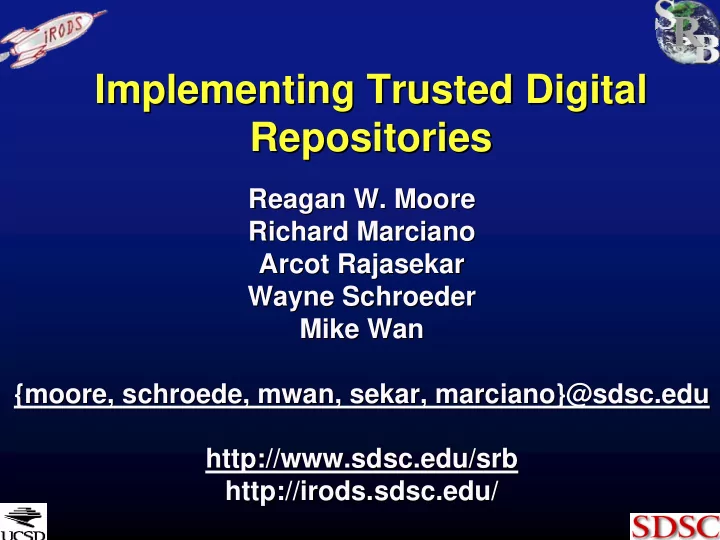

Implementing Trusted Digital Implementing Trusted Digital Repositories Repositories Reagan W. Moore Reagan W. Moore Richard Marciano Richard Marciano Arcot Rajasekar Rajasekar Arcot Wayne Schroeder Wayne Schroeder Mike Wan Mike Wan {moore moore, , schroede schroede, , mwan mwan, , sekar sekar, , marciano}@sdsc.edu marciano}@sdsc.edu { http://www.sdsc.edu/srb http://www.sdsc.edu/srb http://irods.sdsc.edu irods.sdsc.edu/ / http://
Topics Topics • Representation information for preservation environments • How can preservation policies and procedures be characterized? • Rule-based data management systems • How do we make assertions about the trustworthiness of a preservation environment? • Theory of digital preservation • What are the components on which a theory could be based?
Digital Preservation Digital Preservation • Preservation is communication with the future • How do we incorporate new technology (information syntax, encoding format, storage infrastructure, access protocols) in a preservation environment? • SRB - Storage Resource Broker data grid provides the interoperability mechanisms needed to manage multiple versions of technology (infrastructure independence) • Preservation manages communication from the past • What information do we need from the past to make assertions about preservation assessment criteria? • iRODS - integrated Rule-Oriented Data System
Assessment Criteria Assessment Criteria • Authenticity • Management of descriptive information about record provenance, record representation information • Integrity • Minimization of the risk of data loss • Chain of custody • Verification of archivist management policies • Respect des fonds • Preservation of the original arrangement of the records • Trustworthiness • RLG/NARA assessment criteria - 174 rules
Controlling Remote Operations Controlling Remote Operations iRODS - - integrated Rule integrated Rule- -Oriented Data System Oriented Data System iRODS Da ta Ma nage ment Co nserve d Co ntrol Re mote Properties Me cha nis ms Op era tion s Environment Ma nage ment Assessment Ma nage ment Ca pabil ities Functions Cr iteria Policies Da ta Ma nage ment Pers istent Rules Micro -serv ices Infrastructure State Phy sical Da tabase Rule Engine Storage Infrastructure System
Representation Information for Representation Information for Preservation Environments Preservation Environments • Assessment criteria • Mapped to sets of persistent state information • Management policies • Mapped to sets of rules • Preservation processes • Mapped to sets of micro-services • Rules generate persistent state information by controlling the execution of sets of micro- services at remote storage systems
Example Rule Example Rule • Rule composed of four parts: • Name | condition | micro-service set | recovery set • Rule to automate replication of data for a specific collection acPostProcForPut | $objPath like /tempZone/home/rods/nvo/* | msiSysReplDataObj(nvoReplResc,null) | nop
Infrastructure Independence Infrastructure Independence • Distributed Data Management • Data virtualization • Storage protocol independence • Trust virtualization • Administrative domain independence • Federation • Manage interactions between independent data grids • Rule-based Data Management • Management virtualization • Automating execution of management policies • Coupling management policies to assertions about data
Data Virtualization Data Virtualization Access Interface Access Interface Map from the Map from the actions requested by actions requested by Standard Access Actions Standard Access Actions the access method the access method to a standard set of to a standard set of Data Grid Data Grid micro- -services used services used micro to interact with the to interact with the Standard Micro- -services services Standard Micro storage system storage system Storage Protocol Storage Protocol Storage System Storage System
Micro- -services services Micro • Examined Electronic Records Archive capabilities list • Identified 174 micro-services for manipulation of data and structured information • Identified 212 metadata attributes (persistent state information) across six name spaces • Users • Files • Storage systems • Rules • Micro-services • Persistent state information
Federation Between Data Grids Federation Between Data Grids Data Access Methods (Web Browser, DSpace, OAI-PMH) Data Collection A Data Collection B Data Grid Data Grid • Logical resource name space • Logical resource name space • Logical user name space • Logical user name space • Logical file name space • Logical file name space • Logical rule name space • Logical rule name space • Logical micro-service name • Logical micro-service name • Logical persistent state • Logical persistent state
Theory of Digital Preservation Theory of Digital Preservation • Definition of the persistent name spaces • Definition of the operations that are performed upon the persistent name spaces • Characterization of the changes to the persistent state information associated with each persistent name space that occur for each operation • Characterization of the transformations that are made to the records for each operation • Demonstration that the set of operations is complete, enabling the decomposition of every preservation process onto the operation set. • Demonstration that the preservation management policies are complete, enabling the validation of all preservation assessment criteria. • Demonstration that the persistent state information is complete, enabling the validation of assessment criteria. • The assertion is then: if the operations are reversible, then a future preservation environment can recreate a record in its original form, maintain authenticity and integrity, support access, and display the record. • A corollary is that such a system would allow records to be migrated between independent implementations of preservation environments, while maintaining authenticity and integrity .
For More Information For More Information Reagan W. Moore San Diego Supercomputer Center moore@sdsc.edu http://www.sdsc.edu/srb/ http://irods.sdsc.edu/
Recommend
More recommend